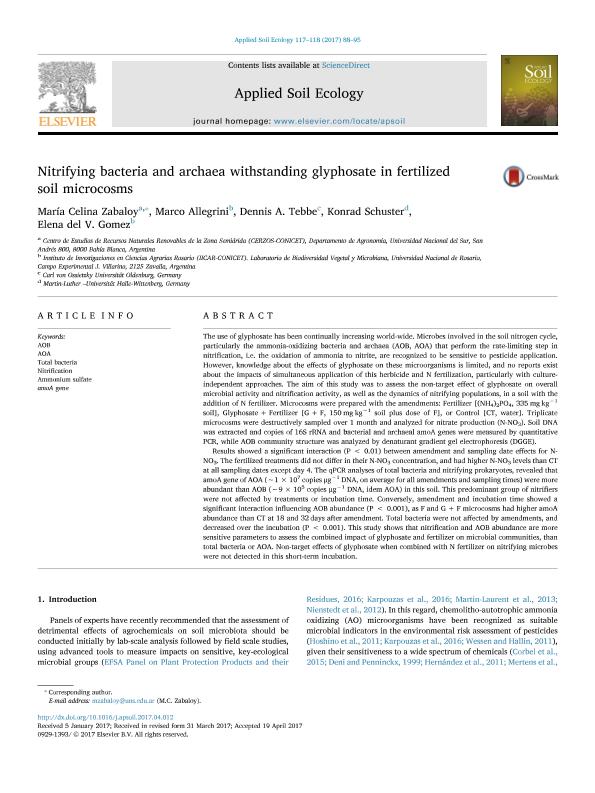Artículo
Nitrifying bacteria and archaea withstanding glyphosate in fertilized soil microcosms
Zabaloy, Maria Celina ; Allegrini, Marco
; Allegrini, Marco ; Tebbe, Dennis A.; Schuster, Konrad; Gomez, Elena del Valle
; Tebbe, Dennis A.; Schuster, Konrad; Gomez, Elena del Valle
 ; Allegrini, Marco
; Allegrini, Marco ; Tebbe, Dennis A.; Schuster, Konrad; Gomez, Elena del Valle
; Tebbe, Dennis A.; Schuster, Konrad; Gomez, Elena del Valle
Fecha de publicación:
09/2017
Editorial:
Elsevier Science
Revista:
Applied Soil Ecology
ISSN:
0929-1393
Idioma:
Inglés
Tipo de recurso:
Artículo publicado
Clasificación temática:
Resumen
The use of glyphosate has been continually increasing world-wide. Microbes involved in the soil nitrogen cycle, particularly the ammonia-oxidizing bacteria and archaea (AOB, AOA) that perform the rate-limiting step in nitrification, i.e. the oxidation of ammonia to nitrite, are recognized to be sensitive to pesticide application. However, knowledge about the effects of glyphosate on these microorganisms is limited, and no reports exist about the impacts of simultaneous application of this herbicide and N fertilization, particularly with culture-independent approaches. The aim of this study was to assess the non-target effect of glyphosate on overall microbial activity and nitrification activity, as well as the dynamics of nitrifying populations, in a soil with the addition of N fertilizer. Microcosms were prepared with the amendments: Fertilizer [(NH4)2PO4, 335 mg kg−1 soil], Glyphosate + Fertilizer [G + F, 150 mg kg−1 soil plus dose of F], or Control [CT, water]. Triplicate microcosms were destructively sampled over 1 month and analyzed for nitrate production (N-NO3). Soil DNA was extracted and copies of 16S rRNA and bacterial and archaeal amoA genes were measured by quantitative PCR, while AOB community structure was analyzed by denaturant gradient gel electrophoresis (DGGE). Results showed a significant interaction (P < 0.01) between amendment and sampling date effects for N-NO3. The fertilized treatments did not differ in their N-NO3 concentration, and had higher N-NO3 levels than CT at all sampling dates except day 4. The qPCR analyses of total bacteria and nitrifying prokaryotes, revealed that amoA gene of AOA (∼1 × 107 copies μg−1 DNA, on average for all amendments and sampling times) were more abundant than AOB (∼9 × 105 copies μg−1 DNA, idem AOA) in this soil. This predominant group of nitrifiers were not affected by treatments or incubation time. Conversely, amendment and incubation time showed a significant interaction influencing AOB abundance (P < 0.001), as F and G + F microcosms had higher amoA abundance than CT at 18 and 32 days after amendment. Total bacteria were not affected by amendments, and decreased over the incubation (P < 0.001). This study shows that nitrification and AOB abundance are more sensitive parameters to assess the combined impact of glyphosate and fertilizer on microbial communities, than total bacteria or AOA. Non-target effects of glyphosate when combined with N fertilizer on nitrifying microbes were not detected in this short-term incubation.
Palabras clave:
Ammonium Sulfate
,
Amoa Gene
,
Aoa
,
Aob
,
Nitrification
,
Total Bacteria
Archivos asociados
Licencia
Identificadores
Colecciones
Articulos(CCT - ROSARIO)
Articulos de CTRO.CIENTIFICO TECNOL.CONICET - ROSARIO
Articulos de CTRO.CIENTIFICO TECNOL.CONICET - ROSARIO
Citación
Zabaloy, Maria Celina; Allegrini, Marco; Tebbe, Dennis A.; Schuster, Konrad; Gomez, Elena del Valle; Nitrifying bacteria and archaea withstanding glyphosate in fertilized soil microcosms; Elsevier Science; Applied Soil Ecology; 117-118; 9-2017; 88-95
Compartir
Altmétricas



